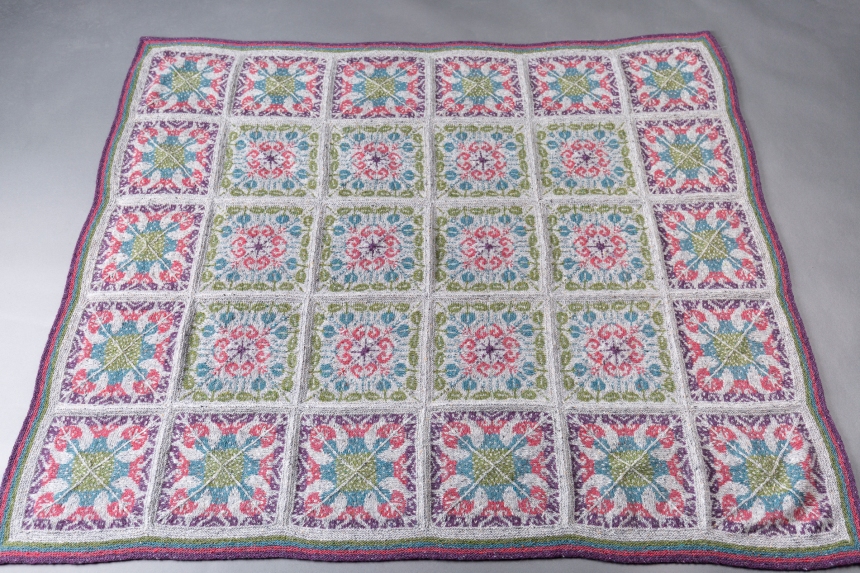One cold Autumn day in the early 2000s, I was travelling on a pacer train between Hull and York. For those of you unfamiliar with UK train travel, pacers are notoriously slow, rickety, and chilly conveyances, and I was keeping myself warm with my new favourite hobby – knitting. I’d recently taken up my needles again after a very long hiatus, and had found myself enthusiastically casting on a number of quick-knit pullovers and cardigans in some lovely chunky yarn. The yarn was glorious to work with, and my new sweaters may have been swift to make, but designed in pieces, they took an awful long time for me to seam. And though I wore my handmade garments with considerable pride, their finished look was, by any standards, rather shonky. With a ball of yarn and a pair of needles I’d quickly felt like I could be a knitting natural, but a natural finisher I knew that I was not. As a constitutionally messy child, I’d always tried to finish things off neatly, but, whether it was the stitched hem of my school skirt or something I’d drawn and coloured, the edges of things had always proved my bugbear. While my classmates stitched precise and orderly rows of blanket stitch, or created perfectly painted trees and houses, my efforts were always blobby and uneven. Now as an untidy adult keen on making her own clothes, my wonky seams and messy edges had returned to haunt me once again.
That day on the train, I was knitting a pattern from a new American publication I’d found in a local bookshop. The pattern was for a pair of garter-stitch fingerless mitts, of the familiar type with a bound-off thumb gap, that are knitted from side to side. I’d already been startled by the ease and simplicity of the wrap-and-turn short rows that the pattern used to fit the first mitt neatly around the hand and wrist (I could add wee wedges into my knitting? What kind of shaping alchemy was this?!) but the designer had another trick up her sleeve. When I’d completed the hand shaping, rather than binding off as usual, I was instructed to find a third needle, and do things a little differently. I followed the pattern, holding my needle tips parallel to one another, working stitches from front and back together with my third needle, and passing each newly formed single stitch over the last. Something interesting was happening in my hands.
Outside the window, the flat fields of East Yorkshire stretched away in the autumn sun, some red-brown, bare and stubbled, some planted with green turnips, whose tops were grazed by hungry sheep. I generally enjoyed the turnip fields and my sheep friends, but I wasn’t too interested in looking at them today. Completely absorbed, I worked away with my three needles, bound off my last stitch, snipped the yarn end, and passed it through the final loop. And then I gazed down at the thing which I had made. A completed mitt! A mitt with no seam, but just this line of even stitches blending invisibly into the rhythm of the surrounding garter stitch! I examined the fabric of the mitt more closely, running my fingers along the bound-off ridge my third needle had produced. This edge was incredibly neat, and I’d just made it with my knitting—I’d not picked up a tapestry needle or sewn anything at all. So it was possible to make a neat seamed edge without actually seaming? How very, very nifty this knitting business was!
Back then, I spent a lot of time on chilly trains, and so I knit a lot of garter-stitch mitts that Autumn. I gifted many pairs, and to anyone who appeared remotely interested in my handiwork, I’d enthuse (while their eyes invariably glazed over) about the design’s firm, neat finish, and the seam that was not a seam at all. And though I loved the rhythmic knit, knit, knit of working garter stitch over a pattern whose construction had become so familiar it felt like a sort of second nature, I increasingly found that I liked finishing my mitts off most of all. Could this be right? Could I be someone who actually enjoyed finishing off edges? Apparently so, for I’d discovered a particular kind of joy in creating that seam-that-was-not-a-seam, and in the small thing in my hands that only needed a little blocking, rather than all that fiddling around with pins, tape measures, tapestry needles. Perhaps finishing off a project was more a matter of technique, and of approach, of simply finding the right way of doing things, a way that worked for me. Perhaps there might be different ways of finishing things off seamlessly, perhaps, if I read more and learnt more about knitting, I’d discover that there were other interesting, and more knitterly, types of seams. Perhaps the craft of knitting meant that I—a messy person—might find myself to be, in my own way, a neat finisher. And perhaps I’d find that edges could be fun, and not frustrating.

For me, the three needle bind off was transformative. The simple magic of knitting two stitches together, then passing one over the last, helped to completely change my attitude towards the edges of my work, towards finishing off my knitting. Over the years that followed, I went on to discover many other types of nifty bind offs, and the myriad different possibilities of joining one piece of knitted fabric neatly to another piece, but I’ll always have a special affection for 3NBO—and not least because its a technique I’ve featured frequently in my design work. It’s a technique whose firm and flexible characteristics gives a fabulous finish to modular blankets – such as the Sterrie, Shieling , or Let Glasgow Flourish blankets.

It’s a great way of finishing off a turned neckband, like those on Wryit or the Carbeth Cardigan.

And it It’s a brilliantly simple method of joining shoulders, whether on pullovers such as Seavaiger or cardigans like St Catherines – where it’s possible to make a feature of the bind-off’s satisfyingly raised, ridged edge.

It always feels satisfying to complete a seamless garment with a finish that is so simple, so neat, and so knitterly.
Hurrah for 3NBO!

I wrote this piece for the 10 Years in the Making club, and was reminded of it when working a 3NBO yesterday. The “American Publication” I’d bought a copy of was Melanie Falick’s “Weekend Knitting” (2003), and the fingerless mitts which taught me about the wonders of the three needle bind off were designed by the brilliant Ann Budd. This is a great, simple, go-to mitt pattern, written for 3 different gauges.


As always Kate, an inspiring article. Can you show us a picture of your mittens please? I realize you can’t share pattern as it is someone else’s but a little picture may be allowed?
I joined the Bluestocking Club and am loving every minute of it! A fabulous idea so well followed through!
LikeLike
I’m afraid I no longer have the mitts – knitted 18 years ago!
LikeLike
I used to be a knitter, but haven’t picked up needles for years. However, reading your article was really interesting and motivating. Thank you so much! Julie
LikeLiked by 1 person
time to pick up those needles again, Julie!
LikeLike
Interesting, I recently acquired a copy of Melanie Falick ‘s Weekend Knitting “ where Kate learned 3 nbo! 👍🥰
>
LikeLike
3nbo is indeed like magic. It’s very pleasing.
What was the mitten pattern for the garter stitch mitts, out of interest?
LikeLike
It’s by Ann Budd – I refer to the book its in at the end of the post
LikeLike
I discovered the 3 needle bind off many years ago. It was an epiphany for me. I told a cousin about it and she thought I was a genius. I did tell her I didn’t invent it but she never seemed to grasp that. She mentioned how great it was and how she used it all the time each time we met.
LikeLiked by 1 person
3NBO, I now use on all shoulder seams. I am going to be looking up Russian grafting. The last two v-necked cardigans I knitted have a crocheted button band. Makes buttonholes so much easier. I recently finished a Murmaration scarf, I didn’t do the Turkish cast on, I hadn’t got enough hands. I did manage to join it together with Kitchener stitch but it has twisted.
Knitting is about experimenting and finding what works for you and what you enjoy doing, everything is worth trying once.
LikeLiked by 1 person
You have just reminded me of that book- the first non Rowan set of patterns I ever bought. I remember being blown away by the idea of knitting anything in just a weekend- I’m not a fast knitter… Funnily enough, the first garment I made from it was a pie shawl with a lace edge- I had no idea what I was doing or how the shawl was put together, and largely knitted it on London buses. Over 15 years later I still have both shawl (a regular part of winter outfits) and book!
LikeLiked by 1 person
I tried Kitchener stitch once and had to keep going back and remembering where I was. Then one day while knitting a little sweater for a great-niece, I discovered how well the 3NBO works. I haven’t looked back. Love it!
LikeLiked by 1 person
Isn’t knitting marvelous, so many options, and all with two sticks and some yarn.
LikeLiked by 1 person
Kate, one of the things I have been enjoying with your sweater patterns is how beautifully finished they are. You’ve taught me that the time it takes to finish a project (I-cord bind off, button band ribbons and snaps, et cetera) is absolutely worth it. It’s the little finishing details that are the difference between a garment being handmade and bespoke. Why NOT make my sweater bespoke?!?!
LikeLiked by 1 person
I TOTALLY agree Susan!
LikeLike
How lovely to read about your love of the 3NBO – I too am an afficiado. I use it for the toes of my socks and anywhere I can. I credit Ann Budd and her excellent publication “Getting Started Knitting Socks” for my love of sock knitting.
LikeLiked by 1 person
I don’t mind sewing seams, but I always use 3NBO on shoulder seams because it is so smooth and doesn’t add bulk, and you can just continue useing the yarn you are knitting with. It’s also strong.
LikeLike
Like you I hate sewing up and think 3NBO very neat. I am also not very good at grafting. Could you use 3NBO in place of grafting under the arms on sweaters such as Coofle? If I have to graft I normally resort to Russian grafting. How is your veg garden this year? Take care
LikeLike
Like you, I enjoy the actual knitting so much more than the making up. I know structural seams (side seams) are reckoned to be vital to the construction and wearability of some garments, but give me an ‘in the round’ knit, even with a steek (which aren’t nearly as fearsome as they might seem at first) any day!
And yes, the 3nbo is great.
LikeLike
Phew! It had not occurred to me that there were other knitters who avoided sewing up, and who gained an unusual pleasure from techniques such as 3nbo….thank you, and thank you for another lovely article
LikeLiked by 1 person
Oh join the club (or rather may I join yours?), the ‘not liking finishing’ club! Just last night I joined the shoulder seams in 3NBO on a very fine knit sleeveless pullover, and after a few stitches, having started wrong sides together, I unpicked it and started again right sides together, which puts the ridged seam on the inside and on the outside you honestly can’t see it. Now everyone else may already know this, but I was very excited and relieved to have made the discovery. Can one, I wonder, pickup and knit the side seams, and then bind them again off like that?
LikeLiked by 1 person
re side seams – my feeling is that the row to stitch ratio might prove tricky (one thing about the 3NBO is that it draws in a wee bit) – but once you cracked that – there’s no reason why not!
LikeLike
I like the process of knitting, but if a garment is made in sections, I avoid it. I really don’t like seams and much prefer the look of a seamless garment. They are so much easier to make as well, in my opinion. I have tried the three needle bind off on a Carbeth, but I cannot remember what I thought of it. I’m trying, unsuccessfully, to find a pattern for a plain raglan sleeve cardigan at the moment, but so far, no luck. I may have to design my own.
LikeLiked by 1 person
I have a plain raglan cardigan pattern – which is easy to adapt and modify to your own requirements, Jacqueline: https://www.shopkdd.com/sweaters-and-cardigans/evendoon-cardigan-kit-or-download
LikeLike
Thankfully the Pacers are now a thing of the past – the final ones in the UK were phased out just a couple of weeks ago.
LikeLike